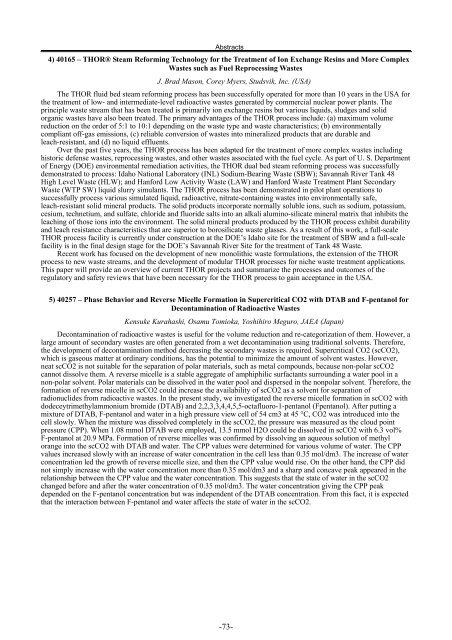ASME Message
ASME Message
ASME Message
You also want an ePaper? Increase the reach of your titles
YUMPU automatically turns print PDFs into web optimized ePapers that Google loves.
Abstracts<br />
4) 40165 – THOR® Steam Reforming Technology for the Treatment of Ion Exchange Resins and More Complex<br />
Wastes such as Fuel Reprocessing Wastes<br />
J. Brad Mason, Corey Myers, Studsvik, Inc. (USA)<br />
The THOR fluid bed steam reforming process has been successfully operated for more than 10 years in the USA for<br />
the treatment of low- and intermediate-level radioactive wastes generated by commercial nuclear power plants. The<br />
principle waste stream that has been treated is primarily ion exchange resins but various liquids, sludges and solid<br />
organic wastes have also been treated. The primary advantages of the THOR process include: (a) maximum volume<br />
reduction on the order of 5:1 to 10:1 depending on the waste type and waste characteristics; (b) environmentally<br />
compliant off-gas emissions, (c) reliable conversion of wastes into mineralized products that are durable and<br />
leach-resistant, and (d) no liquid effluents.<br />
Over the past five years, the THOR process has been adapted for the treatment of more complex wastes including<br />
historic defense wastes, reprocessing wastes, and other wastes associated with the fuel cycle. As part of U. S. Department<br />
of Energy (DOE) environmental remediation activities, the THOR dual bed steam reforming process was successfully<br />
demonstrated to process: Idaho National Laboratory (INL) Sodium-Bearing Waste (SBW); Savannah River Tank 48<br />
High Level Waste (HLW); and Hanford Low Activity Waste (LAW) and Hanford Waste Treatment Plant Secondary<br />
Waste (WTP SW) liquid slurry simulants. The THOR process has been demonstrated in pilot plant operations to<br />
successfully process various simulated liquid, radioactive, nitrate-containing wastes into environmentally safe,<br />
leach-resistant solid mineral products. The solid products incorporate normally soluble ions, such as sodium, potassium,<br />
cesium, technetium, and sulfate, chloride and fluoride salts into an alkali alumino-silicate mineral matrix that inhibits the<br />
leaching of those ions into the environment. The solid mineral products produced by the THOR process exhibit durability<br />
and leach resistance characteristics that are superior to borosilicate waste glasses. As a result of this work, a full-scale<br />
THOR process facility is currently under construction at the DOE’s Idaho site for the treatment of SBW and a full-scale<br />
facility is in the final design stage for the DOE’s Savannah River Site for the treatment of Tank 48 Waste.<br />
Recent work has focused on the development of new monolithic waste formulations, the extension of the THOR<br />
process to new waste streams, and the development of modular THOR processes for niche waste treatment applications.<br />
This paper will provide an overview of current THOR projects and summarize the processes and outcomes of the<br />
regulatory and safety reviews that have been necessary for the THOR process to gain acceptance in the USA.<br />
5) 40257 – Phase Behavior and Reverse Micelle Formation in Supercritical CO2 with DTAB and F-pentanol for<br />
Decontamination of Radioactive Wastes<br />
Kensuke Kurahashi, Osamu Tomioka, Yoshihiro Meguro, JAEA (Japan)<br />
Decontamination of radioactive wastes is useful for the volume reduction and re-categorization of them. However, a<br />
large amount of secondary wastes are often generated from a wet decontamination using traditional solvents. Therefore,<br />
the development of decontamination method decreasing the secondary wastes is required. Supercritical CO2 (scCO2),<br />
which is gaseous matter at ordinary conditions, has the potential to minimize the amount of solvent wastes. However,<br />
neat scCO2 is not suitable for the separation of polar materials, such as metal compounds, because non-polar scCO2<br />
cannot dissolve them. A reverse micelle is a stable aggregate of amphiphilic surfactants surrounding a water pool in a<br />
non-polar solvent. Polar materials can be dissolved in the water pool and dispersed in the nonpolar solvent. Therefore, the<br />
formation of reverse micelle in scCO2 could increase the availability of scCO2 as a solvent for separation of<br />
radionuclides from radioactive wastes. In the present study, we investigated the reverse micelle formation in scCO2 with<br />
dodeceytrimethylammonium bromide (DTAB) and 2,2,3,3,4,4,5,5-octafluoro-1-pentanol (Fpentanol). After putting a<br />
mixture of DTAB, F-pentanol and water in a high pressure view cell of 54 cm3 at 45 °C, CO2 was introduced into the<br />
cell slowly. When the mixture was dissolved completely in the scCO2, the pressure was measured as the cloud point<br />
pressure (CPP). When 1.08 mmol DTAB were employed, 13.5 mmol H2O could be dissolved in scCO2 with 6.3 vol%<br />
F-pentanol at 20.9 MPa. Formation of reverse micelles was confirmed by dissolving an aqueous solution of methyl<br />
orange into the scCO2 with DTAB and water. The CPP values were determined for various volume of water. The CPP<br />
values increased slowly with an increase of water concentration in the cell less than 0.35 mol/dm3. The increase of water<br />
concentration led the growth of reverse micelle size, and then the CPP value would rise. On the other hand, the CPP did<br />
not simply increase with the water concentration more than 0.35 mol/dm3 and a sharp and concave peak appeared in the<br />
relationship between the CPP value and the water concentration. This suggests that the state of water in the scCO2<br />
changed before and after the water concentration of 0.35 mol/dm3. The water concentration giving the CPP peak<br />
depended on the F-pentanol concentration but was independent of the DTAB concentration. From this fact, it is expected<br />
that the interaction between F-pentanol and water affects the state of water in the scCO2.<br />
-73-


